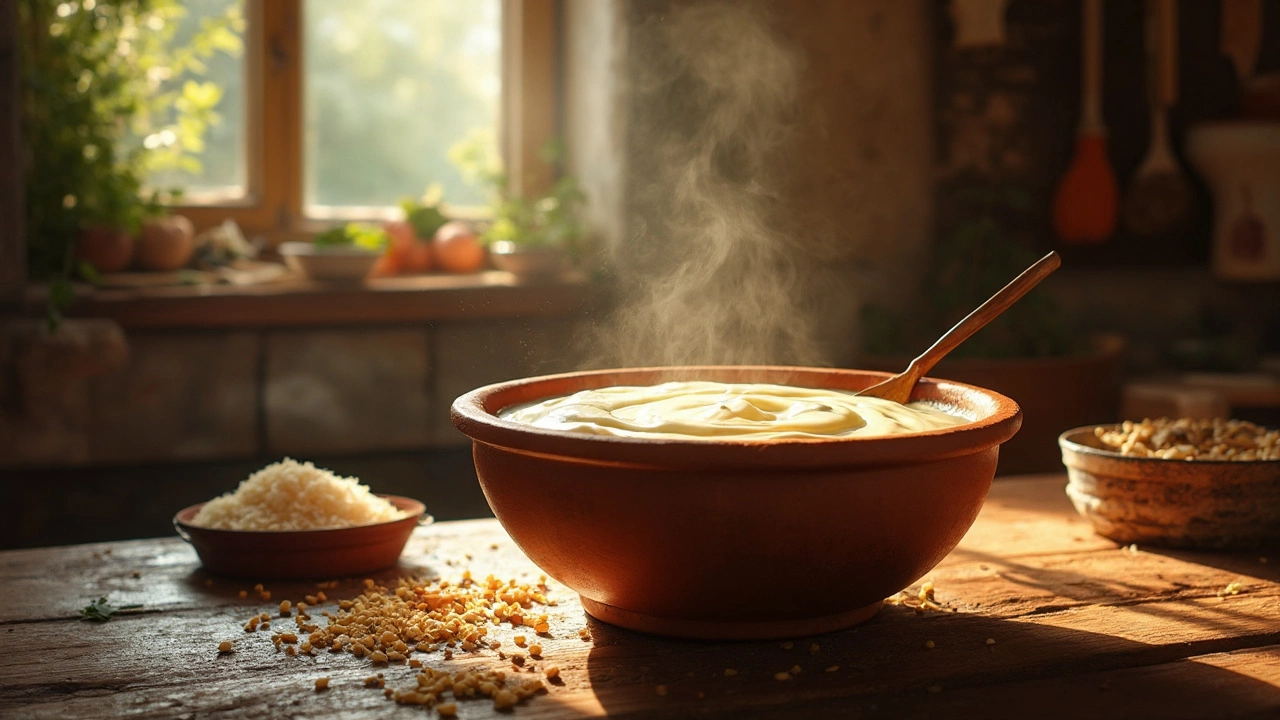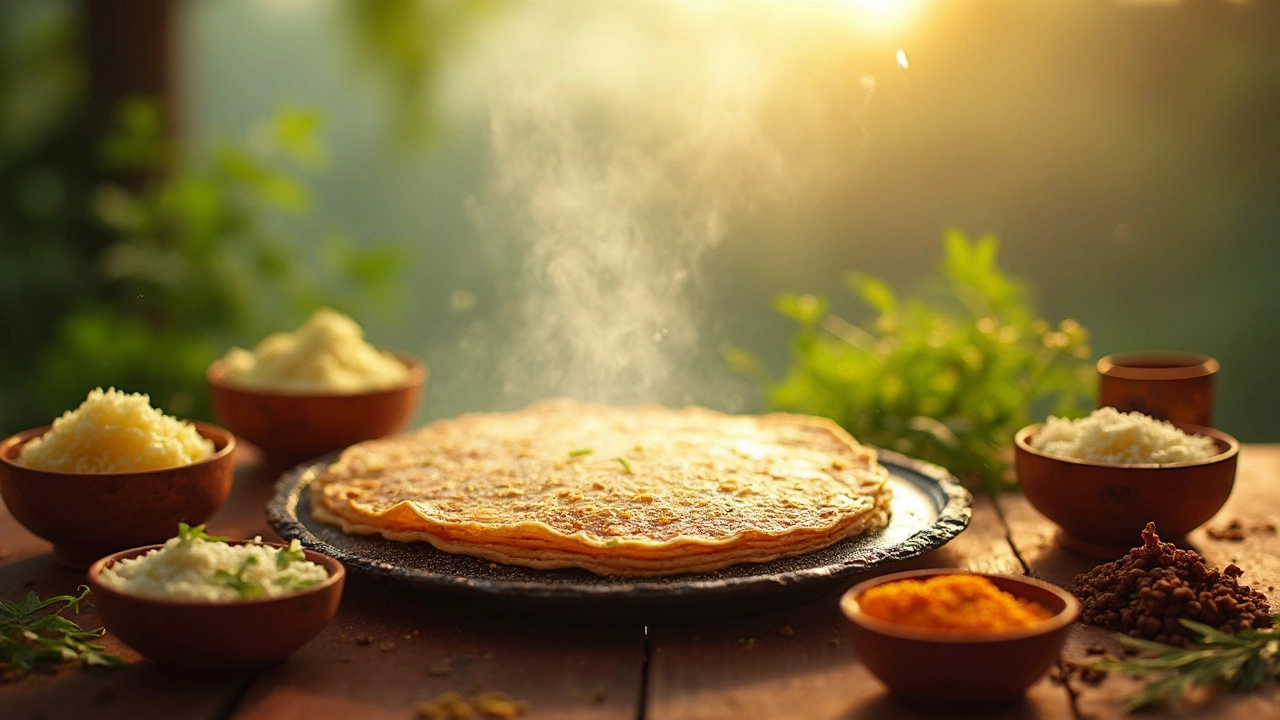Fast and Flavorful: Dosa Batter Fermentation Tricks Without Yeast
 Feb, 17 2025
Feb, 17 2025
So, you're trying to make dosa batter, but yeast seems like one ingredient too many? You're not alone! Many of us prefer the traditional route, which is all about simplicity and getting that authentic dosa taste. Let's talk about how you can achieve that.
First up, why would you skip yeast in the first place? Well, apart from keeping things authentic, it turns out that yeast is not necessary for fermentation. Dosa batter can naturally ferment using just the right mix of rice and dal. Plus, you get to enjoy its natural tangy flavor without any artificial additives.
Getting fermentative action going without yeast means turning to some trustworthy ingredients—like fenugreek seeds. They might look tiny, but they pack a punch when it comes to helping your batter rise. Adding a spoonful of fenugreek can work wonders for both fermentation and taste.
- Why Skip the Yeast?
- Nature’s Fermentation Helpers
- Climate Considerations
- Speeding Up the Process
- Troubleshooting Common Problems
Why Skip the Yeast?
You might be wondering why anyone would want to swap out yeast when it's known for making things rise. Well, when it comes to making homemade dosa batter, there's really no need for it. Dosa is a South Indian staple, and while yeast might speed things up, sticking to traditional methods gives you that authentic taste people love.
Dosa batter ferments beautifully with just rice and dal (like urad dal). The rice and dal combination creates a natural environment for beneficial bacteria to thrive, giving the dosa its distinctive tangy flavor without needing any assistance from yeast.
Preserving Authenticity
Sticking to the classic recipe means preserving traditions. Many families have their dosa batter recipes passed down through generations, and they didn't use yeast. By skipping it, you're keeping the original flavor profiles intact.
Health Benefits
Fermentation, especially when done naturally, boosts the nutritional profile of the batter. The natural process of letting rice and dal sit leads to an increase in essential nutrients, like vitamins B and C.
Not to mention, going yeast-free is a win for those with allergies. Yeast sensitivity, though not super common, does exist. For those affected, natural fermentation provides a way to enjoy dosa without the discomfort.
Environmental Factors
Here's a fun fact: in warmer climates like India, yeast is even less necessary due to higher temperatures and humidity, which provide ideal conditions for natural fermentation. You can literally harness the environment to help your batter thrive.
Nature’s Fermentation Helpers
When you're looking to make that perfect dosa, understanding nature's own fermentation helpers can be a game-changer. Forget about yeast! It's time to let natural ingredients do the work.
Fenugreek Seeds to the Rescue
One of the most effective natural aids you can use in dosa batter is fenugreek seeds. These little guys are not just for adding flavor but can significantly boost fermentation. A small tablespoon added to your soaked rice and dal mix is all you need. They help in breaking down starches, making the batter light and fluffy.
"Fenugreek seeds are packed with an enzyme that naturally enhances fermentation time," explains Dr. Meera Wickramaratne, a renowned food scientist.
Poha: The Secret Ingredient
Have you ever thought about adding flattened rice, or poha, to your batter? A handful can speed up the fermentation process better than you'd think. Not only does poha enhance the texture, but it also gives the batter that slightly sweet and unique flavor.
Here's a simple breakdown:
- Soak rice, lentils, and a bit of poha together.
- Add fenugreek seeds.
- Grind and let the mix sit in a warm place overnight.
In the morning, you'll find a beautifully risen batter ready for your pan!
Temperature Plays a Role
Interestingly, nature helps in more ways than one when it comes to dosa batter. Fermentation is affected by the ambient temperature. Ideally, you want a warm environment. That's why this process is quicker in warmer months or climates. During colder months, a trick is to place the batter in a closed oven with just the oven light on overnight. It's amazing how effective this trick can be.

Climate Considerations
So, what's the deal with climate when it comes to fermenting dosa batter? You'd be surprised how much the surrounding environment can affect the whole process. Warmer climates, particularly like those in southern India, are perfect for getting that batter just right. The key is maintaining the right temperature so that your batter fermentation kicks off smoothly.
Ideal Fermentation Temperature
For ideal results, try to maintain your room temperature between 25°C (77°F) and 32°C (89°F). This range works well because yeast and lactic acid bacteria—your natural fermenters—like it warm and comfy. If you're living in a colder climate, don't worry! There are some tricks to get around that.
Batter Warming Hacks
- Place your bowl of batter inside a switched-off microwave or oven. The enclosed space helps maintain a steady temperature.
- Wrap your container in a thick cloth or keep it near your gas stove, where it might be slightly warmer.
- In really cold areas, some folks use a heating pad set to low underneath the container.
In contrast, if it's scorching outside, you might have to take steps to prevent over-fermentation, which can make the batter too sour. Keep an eye on the clock and check the batter regularly as warmer temperatures can speed up the fermentation process significantly.
When Things Go Too Far
If you're late to check and the batter has turned more sour than expected, no need to panic. Just add a little flattened rice or cooked rice before preparing the dosas to balance out the taste. A small adjustment can keep those dosas delicious!
Speeding Up the Process
If you're impatient to get your dosa game on without much waiting, there are some neat tricks you wouldn't want to miss. Speeding up your batter's fermentation without yeast involves a blend of little tweaks and smart kitchen hacks. Let's break them down.
Use Warm Water
When mixing batter, use warm water instead of cold. Warm water naturally aids fermentation and helps accelerate the process. Be cautious, though; you don't want it too hot, as that can kill the natural fermenting agents. Just a bit warmer than room temperature does the job.
Optimizing Room Temperature
Look around for the warmest spot in your house to leave your fermenting batter. In cooler climates, a closed oven with the light on can create a cozy spot for your batter. Remember, intimacy with heat can easily make your batter rise well.
Include Poha or Flattened Rice
Add a handful of poha or flattened rice when grinding your batter ingredients. Poha acts as a secret ingredient, boosting fermentation by providing extra carbohydrates that yeast love to munch on.
Turbo Charging with a Fermentation Box
If you're someone who frequently makes fermented foods, investing in a fermentation box might be worth it. It keeps your cooking experiments at a consistent temperature, making sure your batter thrives.
Double Your Heat Sources
If you live in a colder region, consider using a heated blanket or placing your bowl near a controlled heat source, like a radiator. But play it safe; avoid direct contact with anything too hot to prevent uneven fermentation.
With these quick hacks in your back pocket, you can enjoy crispy and delicious dosas without waiting an eternity. Give these tricks a whirl in your next cooking session and see the magic unfold!

Troubleshooting Common Problems
Ever busted your back trying to ferment dosa batter and then, boom, it flops? It happens, but let's tackle some common hurdles you might face.
Problem: Batter Isn't Fermenting
If your batter is acting all stubborn and not fermenting, it could be due to temperature. The fermentation process loves warmth, so if your kitchen feels like an icebox, try placing the batter in a warm spot. Adding a pinch of sugar also helps jumpstart the process because sugar is food for the natural bacteria.
Problem: Batter is Too Thick
A thick batter won't spread well, making your dosa thick and chewy, not crispy. To fix this, mix in a bit of water gradually while stirring well. The batter should be a flowing consistency that spreads easily on a hot pan.
Problem: Batter Doesn't Rise
If the batter isn't rising, lack of time might be at fault. Fermentation can take anywhere from 8 to 12 hours. If you're short on time, consider placing the bowl in a warm oven or near a cozy radiator. A little bit of patience and the right environment can go a long way.
Problem: Overly Tangy Batter
Nobody likes overly tangy dosas. If your batter's too sour, it's probably over-fermented. You can try mixing in some fresh batter to balance it out. Keeping your batter in the fridge once it's properly fermented helps slow down the souring process.
Helpful Stats
| Fermentation Time | Temperature (°C) |
|---|---|
| 8 hours | 30-35 |
| 12 hours | 25-30 |
These quick fixes and tips can really save the day when you're looking forward to that perfect dosa. So, next time things don't go as planned, you'll know exactly what to do.